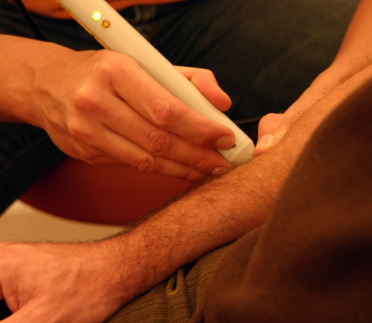Career opportunities for Laser Technicians in pain management include getting employed in different centers that provide personal services such as wellness clinics, spas, sport centers, laser centers, acupuncture clinics, physiotherapy clinics, or veterinary clinics. They can also launch Personal Service Establishments with a small amount of investment to buy equipment or operate a franchise business with different laser production companies to offer services.
This program is offered to students with health backgrounds such as physiotherapists, nurses, massage therapists, acupuncturists, reflex therapists, athletic trainers, occupational therapists, chiropractors, medical doctors, pharmacists, psychologists, estheticians, and cosmetologists wanting to expand their knowledge and receive certification in Laser Therapy to expand existing businesses and practices.
Ask A Question Here:
Course topics include:
- The role of laser therapy to reduce pain and joint inflammation.
- Therapeutic protocols and guidelines for effective treatment of chronic and acute pain.
- Laser therapy to accelerate the repair of soft tissue, bone and cartilage.
- Therapeutic parameters in wound healing.
- Therapeutic techniques in modulation of immune system.
- Evaluating the effect of Laser Therapy after treatment.
- Laser therapy following injury or surgery.
- Laser therapy for neural damage.
“Biostimulation lasers, also called low level laser therapy (LLLT), cold lasers, soft lasers, or laser acupuncture devices, were cleared for marketing by FDA through the Premarket Notification/510(k) process as adjunctive devices for the temporary relief of pain. These clearances were based on the presentation of clinical data to support such claims.” The clinical application of low level laser radiation for the treatment of acute and chronic pain is now a well-established procedure.
Laser Therapy is non-invasive and without side effects. This technique can be applied by laser technicians to control pain and the process takes effect over a period of 4-6 months; in addition, the amount of consumption of painkillers and the consequence of side effects of these drugs will be reduced. Therefore, to deliver safe and better services to clients with pain, it is necessary to educate and train laser technicians for this purpose.
Some Facts:
Based on the report of Canadian Pain Society on March 21, 2011, “the moderate-to-severe chronic pain is hitting the economy where it really hurts: in lost productivity and absenteeism. In the past three months, nearly one-third of all Canadians (32 per cent) report having suffered a loss of income, booked off sick days, experienced a reduction in workplace productivity and responsibility, or even lost their jobs as a result of their pain.”
A National Health Population survey estimates that chronic pain costs Canadians approximately $14,744 per affected person per year. Estimates place direct health care costs for Canada at more than $6 billion per year (in year 2000 dollars) for individuals suffering from chronic pain. By 2025, these costs are expected to rise to more than $10 billion per year. Of all Canadians surveyed, well over half (56 per cent) experienced moderate-to-severe pain in the past three months. Pain occurrence varies across Canada.
Regional Prevalence of Pain

Health Canada and USA FDA have approved low level laser therapy as a modality for pain control, and more than 30 medical laser devices are approved and have Medical Device Licenses by Health Canada to sell and distribute within Canada.

